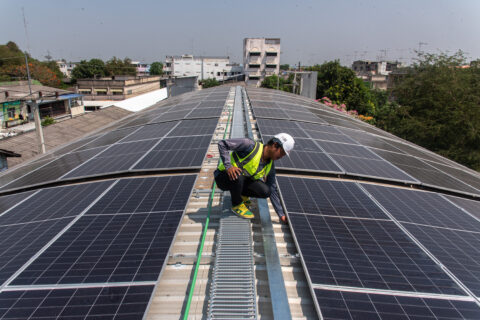Despite coal-power output in the US falling to its lowest level in nearly 60 years, the nation’s greenhouse gas emissions fell by just 0.2% in 2024, according to new research from the Rhodium Group.
Increases in electricity demand and continued growth in transport emissions led to US emissions remaining broadly “unchanged”, while the economy grew by 2.7%, the New York-based research group finds.
The US is the world’s second-largest annual emitter, has very high per-capita emissions and by far the greatest historical responsibility for current warming.
Even though emissions remained unchanged from a year earlier, they were still 8% below pre-pandemic levels in 2024 and remained about 20% below 2005 levels, Rhodium notes.
While the pace of decarbonisation slowed in 2024, after a reduction of 1.9% in 2023, new policies and regulations introduced under the Biden administration were expected to see this accelerate in the coming years, Rhodium says.
However, it notes that this progress could now be at risk from the incoming presidency of Donald Trump. Trump has repeatedly pledged to roll back a range of environmental policies brought in by his predecessor Joe Biden.
Solar and wind overtake coal
Renewable energy in the US grew in 2024, with the combined output from solar and wind surpassing coal in the electricity mix for the first time ever, according to Rhodium.
Together, solar and wind made up 16% of the electricity mix in 2024, up nearly two percentage points from 2023. Solar generation grew by 32% and wind by 7%, both outpacing the 4% growth in gas generation, the report notes.
Solar had a record-setting year in 2024, accounting for 64% of all new electricity-generating capacity added to the US grid in Q3, according to the Solar Energy Industries Association.
However, the rollout of wind generation was hit by notable challenges, including increased costs and project siting difficulties.
Gas-fired electricity generation remained the single-largest source in the US by far, producing a record 1,782 terawatt hours (TWh) in 2024, some 43% of the total.
Nuclear was the second-largest, as shown in the figure below. It generated 781TWh, some 19% of the total, just ahead of the combined output of wind and solar, as well as coal.

The growth of wind and solar helped ensure that the generation mix was “slightly cleaner” in 2024, even though demand for electricity rose by 3%, says Rhodium.
Buildings represented the biggest increase in demand for electricity, where a 10% growth in “cooling degree days” – a measure of how hot the temperature is – drove up summer electricity use. (The US saw record-breaking heatwaves across the year, with the summer of 2024 the hottest on record, the Guardian reported.)
After buildings, industry ranked second and commercial buildings third as the biggest sources of increased electricity demand.
There has been a lot of media focus on artificial intelligence (AI) driving electricity demand growth. Moreover, a Department of Energy-commissioned study in December found that US data centre power demand could nearly triple within four years, consuming as much as 12% of the country’s electricity by 2028.
However, Rhodium notes that data centres were only a small source of demand growth in 2024, representing just a fraction of the third biggest source of electricity demand.
In 2024, the additional power demand was met by gas, wind and solar, while coal continued to decline, dropping one percentage point to 16% of the electricity mix.
In absolute terms, coal provided as much power in 2024 as it did in 1967 when Lyndon Baines Johnson was the 36th president of the US, the Vietnam War was raging and Elvis Presley married Priscilla Ann Beaulieu in Las Vegas.
Gas remained the single largest source of power in the US in 2024, accounting for 43% of the total (1 percentage point higher than in 2023), notes Rhodium.
This growth – to meet increased demand – offset the reduction in coal generation and emissions from the power sector increased by 0.2% (3m tonnes of carbon dioxide equivalent, MtCO2e) in 2024.
Alongside the increase in renewable energy, the US saw record-high investment in the manufacturing and deployment of clean technologies last year, Rhodium says.
For example, investment in clean technologies accounted for 5% of total private investment in structures, equipment and durable consumer goods in the third quarter of last year, according to the latest data from the Clean Investment Monitor.
Crude oil production was up by 2.4% in 2024, while gas production fell by 0.6%, according to Rhodium. This was a slightly bigger drop in gas production than in 2020 when the Covid pandemic hit, as producers reacted to lower prices by drilling fewer new wells and curtailing production, it adds.
The research estimates that oil and gas systems released around 10% less methane per unit of output in 2024 than in 2022, due to cleaner production practices as well as state and federal regulations.
As such, cleaning up oil and gas production led to a 3.7% drop in emissions from the sector, some 11MtCOe relative to 2023.
Hurricanes hit industrial emissions
Industrial emissions fell in 2024 due to low manufacturing output, Rhodium finds. Across the year, the sector’s emissions fell by 1.8%, or 22MtCO2e, from 2023.
Chemicals, computers and electronics, and paper production grew in 2024, but declines in food and beverages, mining and machinery offset these gains, it says.
This included historically low coal mining activity, which fell by 12% in 2024 to its lowest level in decades due to demand falling, as coal power plants retire and are replaced by renewables and gas, as noted in the section above.
One factor in declining industrial output was extreme weather. Along with the impact of labour disruption on production, Hurricanes Beryl, Milton and Helene also all hit manufacturing output, notes Rhodium.
Transport remained the highest-emitting sector in the US, with a 0.8% increase in emissions driven by post-pandemic rebounds in jet fuel and petrol consumption, according to Rhodium.
Emissions from transport, industry and buildings have remained relatively steady in recent decades, whereas the power sector has seen steady declines, as shown in the figure below.

“Available seat miles” – a metric used to quantify air travel – set a new record in 2024, up 6% year-on-year in the first three quarters of the year, according to Rhodium.
There was also “record-high road activity” the report notes, with a 1% increase in road traffic volumes up to October. As such, petrol consumption increased, although diesel continued to fall, dropping close to 2020 levels.
Despite these increases in transportation activity, emissions from the sector still remain 2.%% below 2019 levels.
Building sector emissions increased by 0.4% due to elevated fuel use, Rhodium adds.
Looking ahead
The “modest 2024 decline underscores the urgency of accelerating decarbonisation in all sectors” concludes Rhodium, in particular with the imminent change in US government.
Currently, the US is not on track to meet either its 2030 Paris Agreement target of a 50-52% reduction in emissions relative to 2005 levels or its newly set 2035 goal of a 61-66% reduction.
To bridge the gap between the current US trajectory and its stated goals would require an average emissions reduction of 7.6% every year from 2025 through to 2030, says Rhodium. This would be more than two-thirds of the drop seen as a result of Covid lockdowns in 2020.

Analysts, including Rhodium, have predicted that the combined impact of the Inflation Reduction Act (IRA), Infrastructure Investment and Jobs Act and Environmental Protection Agency (EPA) regulations on vehicles and power plants will increase the pace of emissions reductions in the future.
There is already some evidence of this, with the most recent data from Clean Investment Monitor suggesting that clean energy and transportation investment could reach a high of $71bn in the third quarter of 2024.
This would cap the “nearly unbroken streak of quarter-on-quarter growth since the IRA’s passage, with clean investment now accounting for a record 5% of total US private investment”, notes Rhodium.
However, whether the rate of emissions reduction actually accelerates is heavily dependent on the extent to which the incoming Trump administration and the Republican Congress rollback and repeal EPA regulations and energy and tax policies brought in or expanded through the IRA.
Trump has repeatedly promised to pull back climate policies, saying in September 2024 that “to further defeat inflation, my plan will terminate the Green New Deal, which I call the Green New Scam” in reference to the IRA, according to Politico.
In December, Rhoiodum published a separate piece of research dubbed: “Trump 2.0: What’s in Store for US Energy and Climate?” It explored a number of potential pathways the Trump administration could pursue when he takes office on 20 January, including one called “rollbacks and repeal”.
This pathway would see the pace of US decarbonisation slow significantly, leaving emissions at 24-40% below 2005 levels in 2035. This is equivalent to roughly an additional 1bn tonnes of CO2e in 2035 in each emissions scenario explored by Rhodium.
Rolling back regulations alone could lead to a 270-470MtCO2e increase in emissions by 2035, it adds. This would represent 25-50% of the total emissions increase under the full “rollbacks and repeal” pathway.
Analysis by Carbon Brief in March 2024 found that Trump winning November’s presidential election could lead to a cumulative additional 4bn tonnes of US emissions by 2030, compared to under Bidens’s plans.
Ben King, co-author of the preliminary emissions analysis and Trump 2.0 note, and an associate director in Rhodium Group’s energy and climate practice, tells Carbon Brief:
“It’s not clear what precise policy actions the Trump administration and Republican-controlled Congress will take, but we analysed the potential impacts of two major policy changes: rolling back major climate regulations from the Environmental Protection Agency (EPA) and repealing the energy and tax policies that were enhanced and expanded through the Inflation Reduction Act (IRA). Rolling back EPA climate regulations alone – which the Trump administration could pursue unilaterally, though not immediately – could increase greenhouse gas emissions by 270-470MtCO2e in 2035.
“A more extreme policy pathway, rolling back EPA regulations and immediately repealing the energy and tax components of the IRA – which would require congressional approval – could increase emissions by nearly 1GtCO2e in 2035.”
Rhodium concludes its analysis of the US’s emissions in 2024 by noting that it will be watching developments around rolling back and repealing climate policies “closely”.
The post US emissions ‘unchanged’ in 2024 despite coal power at lowest level since 1967 appeared first on Carbon Brief.
https://www.carbonbrief.org/us-emissions-unchanged-in-2024-despite-coal-power-at-lowest-level-since-1967/
Climate Change
Colombia proposes expert group to advance talks on minerals agreement
Colombia wants countries to discuss options for a global agreement to ensure that the extraction, processing and recycling of minerals – including those needed for the clean energy transition – don’t harm the environment and human wellbeing.
The mineral-rich nation is proposing to create an expert group to “identify options for international instruments, including global and legally-binding instruments, for coordinated global action on the environmentally sound management of minerals and metals through [their] full lifecyle”.
Colombia hopes this will eventually lead to an agreement on the need for an international treaty to define mandatory rules and standards that would make mineral value chains more transparent and accountable.
The proposal was set out in a draft resolution submitted to the UN Environment Assembly (UNEA) earlier this week and seen by Climate Home News. UNEA, which is constituted of all UN member states, is the world’s top decision-making body for matters relating to the environment. The assembly’s seventh session will meet in Kenya in December to vote on countries’ proposals.
Soaring demand for the minerals used to manufacture clean energy technologies and electric vehicles, as well as in the digital, construction and defence industries have led to growing environmental destruction, human rights violations and social conflict.
Colombia argues there is an “urgent need” to strengthen global cooperation and governance to reduce the risks to people and the planet.
Options for a global minerals agreement
The proposal is among a flurry of initiatives to strength global mineral governance at a time when booming demand is putting pressure on new mining projects.
Colombia, which produces emeralds, gold, platinum and silver for exports, first proposed the idea for a binding international agreement on minerals traceability and accountability on the sidelines of the UN biodiversity talks it hosted in October 2024.
Since then, the South American nation has been quietly trying to drum up support for the idea, especially among African and European nations.
Its draft resolution to UNEA7 contains very few details, leaving it open for countries to discuss what kind of global instrument would be best suited to make mineral supply chains more transparent and sustainable.
Does the world need a global treaty on energy transition minerals?
Colombia says it wants the expert group to build on other UN initiatives, including a UN Panel on Critical Energy Transition Minerals, which set out seven principles to ensure the mining, processing and recycling of energy transition minerals are done responsibly and benefit everyone.
The group would include technical experts and representatives from international and regional conventions, major country groupings as well as relevant stakeholders.
It would examine the feasibility and effectiveness of different options for a global agreement, consider their costs and identify measures to support countries to implement what is agreed.
The resolution also calls for one or two meetings for member states to discuss the idea before the UNEA8 session planned in late 2027, when countries would decide on a way forward.
No time to lose for treaty negotiations
Colombia’s efforts to advance global talks on mineral supply chains have been welcomed by resource experts and campaigners. But not everyone agrees on the best strategy to move the discussion forward at a time when multilateralism is coming under attack.
Johanna Sydow, a resource policy expert who heads the international environmental policy division of the Heinrich-Böll Foundation, said she had hoped that the resolution would explicitly call for negotiations to begin on an international minerals treaty.
“Treaty negotiations take a long time. If you don’t even start with it now, it will take even longer. I don’t see how in two or three years it will be easier to come to an agreement,” she told Climate Home.
Despite the geopolitical challenges, “we need joint rules to prevent a huge race to the bottom for [mineral] standards”. That could start with a group of countries coming together and starting to enforce joint standards for mining, processing and recycling minerals, she said.
But any meaningful global agreement on mineral supply chains would require backing from China, the world’s largest processor of minerals, which dominates most of the supply chains. And with Colombia heading for an election in May, it will need all the support it can get to move its proposal forward.
‘Voluntary initiative won’t cut it’
Juliana Peña Niño, Colombia country manager at the Natural Resource Governance Institute, is more optimistic. “Colombia’s leadership towards fairer mineral value chains is a welcome step,” she told Climate Home News.
“At UNEA7, we need an ambitious debate that gives the proposed expert group a clear mandate to advance concrete next steps — not delay decisions — and that puts the voices of those most affected at the centre. One thing is clear: the path forward must ultimately deliver a binding instrument, as yet another voluntary initiative simply won’t cut it,” she said.
More than 50 civil society groups spanning Latin America, Africa and Europe previously described Colombia’s work on the issue as “a chance to build a new global paradigm rooted in environmental integrity, human rights, Indigenous Peoples’ rights, justice and equity”.
“As the energy transition and digitalisation drive demand for minerals, we cannot afford to repeat old extractive models built on asymmetry – we must redefine them,” they wrote in a statement.
Main image: The UN Environment Assembly is hosted in Nairobi, Kenya. (Natalia Mroz/ UN Environment)
The post Colombia proposes expert group to advance talks on minerals agreement appeared first on Climate Home News.
Colombia proposes expert group to advance talks on minerals agreement
Climate Change
California Sanctions Stark Disparities in Pesticide Exposure During Pregnancy
If you’re young, pregnant and Latina, chances are you live near agricultural fields sprayed with higher levels of brain-damaging organophosphate pesticides.
A baby in the womb has few defenses against industrial petrochemicals designed to kill.
California Sanctions Stark Disparities in Pesticide Exposure During Pregnancy
Climate Change
DeBriefed 3 October 2025: UK political gap on climate widens; Fossil-fuelled Typhoon Ragasa; ‘Overshoot’ unknowns
Welcome to Carbon Brief’s DeBriefed.
An essential guide to the week’s key developments relating to climate change.
This week
Shattered climate consensus
FRACKING BAN: UK energy secretary Ed Miliband has announced that the government will bring forward its plans to permanently ban fracking, in a move designed to counter a promise from the hard-right Reform party to restart efforts to introduce the practice, the Guardian said. In the same speech, Miliband said Reform’s plans to scrap clean-energy projects would “betray” young people and future generations, the Press Association reported.
ACT AXE?: Meanwhile, Kemi Badenoch, leader of the Conservatives, pledged to scrap the 2008 Climate Change Act if elected, Bloomberg reported. It noted that the legislation was passed with cross-party support and strengthened by the Conservatives.
‘INSANE’: Badenoch faced a backlash from senior Tory figures, including ex-prime minister Theresa May, who called her pledge a “catastrophic mistake”, said the Financial Times. The newspaper added that the Conservatives were “trailing third in opinion polls”. A wide range of climate scientists also condemned the idea, describing it as “insane”, an “insult” and a “serious regression”.
Around the world
- CLIMATE CRACKDOWN: The US Department of Energy has told employees in the Office of Energy Efficiency and Renewable Energy to avoid using the term “climate change”, according to the Guardian.
- FOREST DELAY: Plans for Brazil’s COP30 flagship initiative, the tropical forests forever fund, are “suffer[ing] delays” as officials remain split on key details, Bloomberg said.
- COP MAY BE ‘SPLIT’: Australia could “split” the hosting of the COP31 climate summit in 2026 under a potential compromise with Turkey, reported the Guardian.
- DIVINE INTERVENTION: Pope Leo XIV has criticised those who minimise the “increasingly evident” impact of global warming in his first major climate speech, BBC News reported.
€44.5 billion
The cost of extreme weather and climate change in the EU in the last four years – two-and-a-half times higher than in the decade to 2019, according to a European Environment Agency report covered by the Financial Times.
Latest climate research
- Fossil-fuelled climate change caused around 36% of Typhoon Ragasa’s direct damage to homes and properties in southern China, according to a rapid impact attribution study | Imperial Grantham Institute – Climate Change and the Environment
- Some 86% of the global population are concerned about climate change, according to a survey of 280,000 people in 142 countries and regions | Climate Policy
- A global shift towards a “planetary health diet” could slash emissions and save tens of thousands of lives each day | EAT-Lancet Commission 2025 report
(For more, see Carbon Brief’s in-depth daily summaries of the top climate news stories on Monday, Tuesday, Wednesday, Thursday and Friday.)
Captured

Clean energy has met 100% of Great Britain’s electricity demand for a record 87 hours this year so far, according to new Carbon Brief analysis. This is up from just 2.5 hours in 2021 and 64.5 hours in all of 2024. The longest stretch of time where 100% of electricity demand was met by clean energy stands at 15 hours, from midnight on 25 May 2025 through to 3pm on 26 May, according to the analysis.
Spotlight
‘Overshoot’ unknowns
As the chances of limiting global warming to 1.5C dwindle, there is increasing focus on the prospects for “overshooting” the Paris Agreement target and then bringing temperatures back down by removing CO2 from the atmosphere.
At the first-ever Overshoot Conference in Laxenburg, Austria, Carbon Brief asks experts about the key unknowns around warming “overshoot”.
Sir Prof Jim Skea
Chair of the Intergovernmental Panel on Climate Change (IPCC) and emeritus professor at Imperial College London’s Centre for Environmental Policy
So there are huge knowledge gaps around overshoot and carbon dioxide removal (CDR). As it’s very clear from the themes of this conference, we don’t altogether understand how the Earth would react in taking CO2 out of the atmosphere.
We don’t understand the nature of the irreversibilities and we don’t understand the effectiveness of CDR techniques, which might themselves be influenced by the level of global warming, plus all the equity and sustainability issues surrounding using CDR techniques.
Prof Kristie Ebi
Professor at the University of Washington’s Center for Health and the Global Environment
There are all kinds of questions about adaptation and how to approach effective adaptation. At the moment, adaptation is primarily assuming a continual increase in global mean surface temperature. If there is going to be a peak – and of course, we don’t know what that peak is – then how do you start planning? Do you change your planning?
There are places, for instance when thinking about hard infrastructure, [where overshoot] may result in a change in your plan – because as you come down the backside, maybe the need would be less. For example, when building a bridge taller. And when implementing early warning systems, how do you take into account that there will be a peak and ultimately a decline? There is almost no work in that. I would say that’s one of the critical unknowns.
Dr James Fletcher
Former minister for public service, sustainable development, energy, science and technology for Saint Lucia and negotiator at COP21 in Paris.
The key unknown is where we’re going to land. At what point will we peak [temperatures] before we start going down and how long will we stay in that overshoot period? That is a scary thing. Yes, there will be overshoot, but at what point will that overshoot peak? Are we peaking at 1.6C, 1.7C, 2.1C?
All of these are scary scenarios for small island developing states – anything above 1.5C is scary. Every fraction of a degree matters to us. Where we peak is very important and how long we stay in this overshoot period is equally important. That’s when you start getting into very serious, irreversible impacts and tipping points.
Prof Oliver Geden
Senior fellow and head of the climate policy and politics research cluster at the German Institute for International and Security Affairs and vice-chair of IPCC Working Group III
[A key unknown] is whether countries are really willing to commit to net-negative trajectories. We are assuming, in science, global pathways going net-negative, with hardly any country saying they want to go there. So maybe it is just an academic thought experiment. So we don’t know yet if [overshoot] is even relevant. It is relevant in the sense that if we do, [the] 1.5C [target] stays on the table. But I think the next phase needs to be that countries – or the UNFCCC as a whole – needs to decide what they want to do.
Prof Lavanya Rajamani
Professor of international environmental law at the University of Oxford
I think there are several scientific unknowns, but I would like to focus on the governance unknowns with respect to overshoot. To me, a key governance unknown is the extent to which our current legal and regulatory architecture – across levels of governance, so domestic, regional and international – will actually be responsive to the needs of an overshoot world and the consequences of actually not having regulatory and governance architectures in place to address overshoot.
Watch, read, listen
FUTURE GAZING: The Financial Times examined a “future where China wins the green race”.
‘JUNK CREDITS’: Climate Home News reported on a “forest carbon megaproject” in Zimbabwe that has allegedly “generated millions of junk credits”.
‘SINK OR SWIM’: An extract from a new book on how the world needs to adapt to climate change, by Dr Susannah Fisher, featured in Backchannel.
Coming up
- 7 October: International Energy Agency (IEA) renewables 2025 report launch
- 8-10 October: World summit of Indigenous peoples and nature, Abu Dhabi, UAE
- 9-15 October: International Union for the Conservation of Nature (IUCN) 2025 congress, Abu Dhabi, UAE
Pick of the jobs
- UK government foreign, commonwealth and development office, senior climate policy adviser | Salary: CA$93,207. Location: Calgary, Canada
- Wellcome Trust, senior research manager, climate and health | Salary: £64,800. Location: London
- Bloomberg, product manager – climate, nature and sustainability regulations | Salary: Unknown. Location: London
DeBriefed is edited by Daisy Dunne. Please send any tips or feedback to debriefed@carbonbrief.org.
This is an online version of Carbon Brief’s weekly DeBriefed email newsletter. Subscribe for free here.
The post DeBriefed 3 October 2025: UK political gap on climate widens; Fossil-fuelled Typhoon Ragasa; ‘Overshoot’ unknowns appeared first on Carbon Brief.
-
Climate Change2 years ago
Spanish-language misinformation on renewable energy spreads online, report shows
-
Climate Change Videos2 years ago
The toxic gas flares fuelling Nigeria’s climate change – BBC News
-
Climate Change2 months ago
Guest post: Why China is still building new coal – and when it might stop
-

 Greenhouse Gases1 year ago
Greenhouse Gases1 year ago嘉宾来稿:满足中国增长的用电需求 光伏加储能“比新建煤电更实惠”
-

 Climate Change1 year ago
Climate Change1 year ago嘉宾来稿:满足中国增长的用电需求 光伏加储能“比新建煤电更实惠”
-
Greenhouse Gases2 months ago
Guest post: Why China is still building new coal – and when it might stop
-

 Carbon Footprint1 year ago
Carbon Footprint1 year agoUS SEC’s Climate Disclosure Rules Spur Renewed Interest in Carbon Credits
-
Renewable Energy3 months ago
US Grid Strain, Possible Allete Sale















